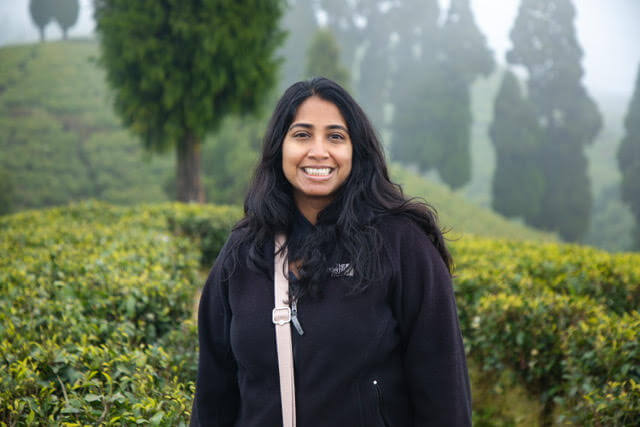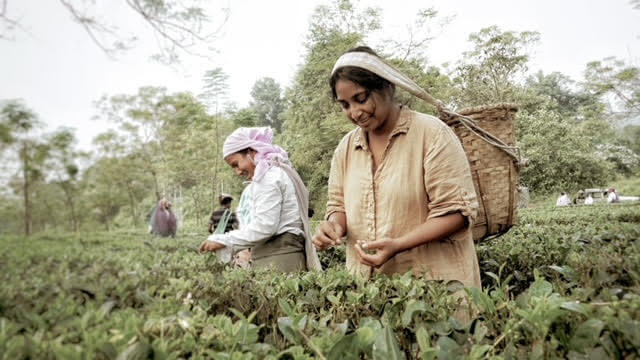No Products in the Cart

I am Poorvi, a tea sommelier, adventurer, and founder of Herbs & Kettles, sharing the narrative of our tea journey. In 2022, my husband Abe and I ventured into the world of tea, driven by a shared passion for exceptional, single-origin, directly sourced loose leaf teas. Our goal extended beyond commerce; we aimed to build a community around tea and foster bonds over shared cups.
Enough about me; let's delve into the intricacies of sourcing teas from Darjeeling tea plantations, focusing on the remarkable Darjeeling teas. Our commitment to building a community with exceptional loose leaf teas led us to seek beyond the sprawling Darjeeling tea estates owned by detached landowners. Many of these owners residing in Kolkata viewed tea as a mere commodity to enhance their wealth, neglecting the well-being of tea pluckers and their families. This colonial tradition fueled my determination to find small tea farmers committed to fair, sustainable, and ethical practices.
My sourcing journey unveiled Darjeeling tea gardens, where owners actively participated in the tea-making process. These innovative Darjeeling tea farmers specialized in whole leaf teas, employing creative methods like using mats for bruising leaves or rolling machines from China and Taiwan to prevent breakage. Despite their worries about making ends meet, their love for the land and Darjeeling tea production is palpable in every encounter.
Having visited Darjeeling multiple times in my childhood, my first official sourcing trip occurred in 2021. Keen to understand the region and the nuances of different tea flushes, I initiated my exploration online. Finding Darjeeling tea gardens, especially those with Geographical Indication (GI) tags, was relatively straightforward. While GI tagging increased awareness and protected Darjeeling teas from blending with others, it created challenges for small farmers in obtaining the GI Tag certificate due to costs and difficulties with extensive paperwork.
Contacting Darjeeling tea estates for visits proved a selective process, with some hesitant due to their preference for selling large quantities, often exceeding 200 pounds at a time. This preference seemed peculiar, given my emphasis on quality over quantity. Before my trip, I requested samples from Darjeeling tea gardens to experience the nuanced flavors of small growers. The teas these passionate small farmers sent resonated with my taste buds and sparked mutual excitement for collaboration. Herbs & Kettles evolved into a collaborative effort supported by small growers who played a crucial role in establishing our reputation for the best Darjeeling teas in the US.
Darjeeling, not merely a tea type but a tea-producing region, is situated in North East India, encompassing the districts of Darjeeling, Mirik, and Kurseong. Known for its black teas, Darjeeling also produces limited quantities of green and white teas. The historical backdrop reveals the British colonial influence, with attempts to procure tea from China in exchange for opium. The eventual theft of tea plants from China led to the establishment of Darjeeling as a prominent tea cultivation region in 1841.
Post-British colonization, Darjeeling tea became a symbol of status, primarily consumed by wealthy Indian families on special occasions. The colonial legacy persisted until recent years when small tea farmers played a pivotal role in manufacturing. A shining example is Yanki and Allan, a mother-son duo transforming the narrative in their village by uplifting women tea pluckers and producing exceptional teas.
Shop Now: Darjeeling Yanki Red Oolong Tea
Darjeeling's tea varieties span beyond the famous black teas grown in the region, including white and green teas. Experimental farmers delve into oolongs, with Yanki showcasing innovation by crafting rolled oolongs from mature leaves and producing a delightful yellow tea. The coexistence of both Camellia sinensis varieties, Assamica and Sinensis, contributes to the richness of Darjeeling teas, with Assamica varieties growing in the lower parts and Sinensis varieties thriving in the higher altitudes.
Classification based on clonal or chinary types further enhances the diversity of Darjeeling teas. Clonal teas, derived from cuttings, offer a uniform flavor, though they are more susceptible to disease than chinary tea plants grown from seeds. Meanwhile, china bushes from seeds give an interesting nuance array of aromas and flavors. The classification extends to flushes or seasons, with the first flush in spring, the second flush in summer, and the autumnal flush in fall, each capturing the essence of its season.

Read more: The Allure of Darjeeling Tea's Taste: A Journey into Exquisite Terroir
Darjeeling unfolds as a mesmerizing region in the foothills of the mighty Himalayas, sharing proximity with Nepal and Tibet. The large Darjeeling tea fields, adorned with sprawling gardens and tea pluckers, create a picturesque landscape. The mountainous terrain results in an ever-changing climate, where a single day can transition from bright sunshine to heavy cloud cover and rain. Misty mornings and evenings, accompanied by a crisp nip in the air, add to the region's charm.
While summers attract many tourists, spring and fall hold a special place in my heart. Spring anticipates the first flush after months of garden closure, while fall offers the joy of witnessing ripe oranges on the trees. The tea pluckers, predominantly women, earn a daily wage and are provided houses and free grain, and their children receive free education in government-run schools. Despite these provisions, many tea pluckers struggle to escape poverty, exacerbated by the ever-increasing cost of living. The poignant revelation that many tea pluckers are widowed, having lost husbands in the army, adds a layer of sorrow to their stories.
Culinary delights in Darjeeling include thukpa soup, dumplings (momos), rotis with vegetables, and daal. The main festival celebrated in the region is Durga Pooja, during which tea pluckers receive additional pay for a month and a week of vacation.

At Herbs & Kettles, we take pride in collaborating with sustainable, innovative small farmers in Darjeeling. Our close relationships with these farmers provide us access to their best batches. Eliminating middlemen ensures that our teas reach you as fresh as possible, with a farm-to-cup journey. The offerings include the spring freshness of a first flush with its delightful bite, the wine-like notes of a second flush, and the natural honeyed fruitiness of an autumnal flush. In addition to black teas, our small farmers produce superb white teas, green teas, and oolongs. Our white tea boasts sweetness, savoriness, and creaminess, while our green tea is crafted using leaves from special shade-grown Japanese bushes, offering wonderful umami notes. Each tea we selected is a testament to the finest Darjeeling teas globally.
Our commitment extends beyond exceptional teas to ethical and sustainable practices. Visits to the Darjeeling tea gardens we partner with allow us to witness firsthand the efforts invested in fair treatment of employees, pesticide-free cultivation, and environmental respect, including avoiding man-animal conflicts. By choosing Herbs & Kettles, you contribute to our collective efforts to support a red panda conservation project at Signalila National Park, Darjeeling.

Embarking on this enchanting journey through the lens of Darjeeling tea gardens has been a delightful experience. The mountainous, mystical region, often referred to as the producer of the "champagne of teas" – Darjeeling teas, captivates with its beauty, cultural richness, and the resilience of small tea farmers. Our commitment to this journey goes beyond commerce; it's about weaving a tapestry of community, sustainability, and exceptional teas.
As you savor the nuances of Darjeeling teas from Herbs & Kettles, we invite you not just to taste the tea but to savor the stories behind each leaf, the dedication of small farmers, and the terroir that gives Darjeeling teas their unique character. This isn't just a cup of tea; it's an experience in the heart of Darjeeling, where each sip resonates with the spirit of the land, the people, and the passion that defines Herbs & Kettles.